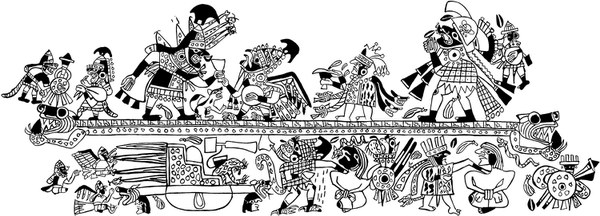The art of the Moche frequently depicts a combination of their natural and supernatural worlds. In addition, the Moche routinely portrayed several scenes involving specific figures and settings. These scenes were repeatedly painted over a long period of time by multiple artists and are referred to as “themes.” Evidence from archaeological excavations tie the figures from these themes to real individuals and several scenes can be linked in narrative sequence. These themes have been the object of extensive scholarly study and offer an extraordinary window into the practices and ritual activities of the Moche.
The Burial Theme
The Burial Theme depicts the interment of an individual of high status, including the preparatory rituals and the presentation of offerings that accompany the body. The scene is often split into the three parts: a presentation of conch (Strombus gigas) shells to elite personages, at times human and at times anthropomorphic; the sacrifice of a nude female; and the lowering of a masked coffin by rope through multiple layers of animal and vessel offerings.
The Presentation Theme
The Presentation Theme, also referred to as the Sacrifice Ceremony, occurs on multiple vessels and even metal and stone objects in both fineline painting and relief, and in both abridged and extended formats. Four central figures are featured and are designated in scholarship as Figures A, B, C, and D. Figure A is known as the “Rayed Deity,” the “Warrior Priest,” “Ai Apaec,” or the “Fanged Deity,” while Figures B and C are known as the “Owl” and the “Priestess,” respectively. Other figures in the scene are depicted preparing prisoners for bloodletting and, ultimately, the presentation of a cup or goblet to Figure A.
This theme is particularly important in the history of Moche research because of its role in identifying archaeological remains. In 1988, excavation at the site of Sipan revealed elite personages with accompanying objects and elements of dress identical to those represented with Figure A in the fineline paintings; meanwhile at the site of Ucupe and San Jose de Moro, The Owl and The Priestess personages were discovered. Finally, at the site of Huaca de Cao, an elite female burial known as the Señora de Cao contained the objects and dress of Figure D. Moreover, elements of architecture and evidence of human sacrifice at the Huaca de la Luna directly correspond to iconography repeated in this theme. The Presentation Theme, therefore, has played a crucial role in scholarship to link iconographic representation and practice in ancient Moche society.
The Revolt of the Objects
The Revolt of the Objects Theme involves figures that appear in other themes of Moche fineline art, such as the Presentation Theme. A Priestess figure, identifiable by her double tassel headdress and long braids, and an anthropomorphized Owl Deity seem to preside over the chaos of the scene. Weapons such as clubs, maces, and slingshots have developed human heads and limbs and attack their human masters. The scene references a long-held concept in the Andes of “pachacuti,” a Quechua term that refers to a social upheaval or cataclysm. Scholars have identified congruencies between the Moche vessel imagery and colonial accounts of local legends in both the Andes and Mesoamerica. These legends are also referenced in the sixteenth-century Quechua-language Huarochirí Manuscript and the Popol Vuh narrative of the Mayan K’iche’ people, which was first written down in the eighteenth century.
The Tule Boat Theme
Tule, reed, balsa, or totora boats appear in fineline painting in varying degrees of abstraction. In a typical Tule Boat Theme scene, two reed boats are depicted and separated by a marine animal. In one boat, a figure is bent at the knee seems to be paddling, while in the other boat, a female figure holds an object, possibly a bag. In some iterations of the theme, tule boats are rendered simply as a crescent shape or not at all, instead using the angles of the vessel to stand in for the boat. Additionally, the scene is thought to have lunar symbolism due to an apparent mutability between the female figure and the Lunar or Crested Animal, a feline-like creature often depicted in a crescent shape.
The Bean and Stick Ceremony
The Bean and Stick Ceremony features two figures, at times human and at times anthropomorphic, typically seated or lying across a stepped dais and holding stick-like objects while surrounded by patterned beans. The scene has also been described as a bean divination.
Ceremonial Badminton/Water Lily Ritual
Ceremonial Badminton refers to scenes that feature a multitude of figures, variously human, anthropomorphic, or supernatural, engaged in what appears to be a ritual competition that involves launching spears at a feathered object that is occasionally tied to string. We do not yet understand the motivation or rules of engagement for this activity. Other interpretations of this scene describe the imagery as depicting a “water lily ritual.”
Runner Theme
Human, anthropomorphic animals, or beans are depicted running and carrying bags. The runners tend to wear alternating disk or trapezoidal headdresses, ulluchu-fruit belts, and are often shirtless. Beans are often depicted in the background. Ethnohistoric accounts of Inca messengers who traveled on foot across the empire, known in Quechua as Chasqui or Chaski, have been used as analogies for these earlier Moche representations of runners.
Coca-Taking
Coca (Erythroxylum coca, E. novogranatense var. truxillense) has played an important role in Andean ritual through time. In Moche fineline art, coca scenes depict two or more figures, usually wearing shrouds or cloaks, seated beneath a bicephalous arc. The figures each hold a gourd and a spatula used to ingest lime, which helps release the alkaloid properties of the leaf. The background is filled with large filled circles, which may allude to a starry night.
